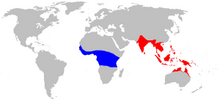| Weaver ant Temporal range: Ypresian – Recent
| |
|---|---|

| |
| Weaver ant (Oecophylla smaragdina) major worker (India). | |

| |
| Weaver ant (Oecophylla longinoda) major worker (Tanzania) | |
| Scientific classification | |
| Domain: | Eukaryota |
| Kingdom: | Animalia |
| Phylum: | Arthropoda |
| Class: | Insecta |
| Order: | Hymenoptera |
| Family: | Formicidae |
| Subfamily: | Formicinae |
| Tribe: | Oecophyllini Emery, 1895 |
| Genus: | Oecophylla Smith, 1860 |
| Type species | |
| Formica virescens (junior synonym of Oecophylla smaragdina) | |
| Diversity[1] | |
| 3 extant species 15 extinct species | |

| |
| Oecophylla range map. Oecophylla longinoda in blue, Oecophylla smaragdina in red.[2] | |
Weaver ants or green ants are eusocial insects of the Hymenoptera family Formicidae belonging to the tribe Oecophyllini. Weaver ants live in trees (they are obligately arboreal) and are known for their unique nest building behaviour where workers construct nests by weaving together leaves using larval silk.[3] Colonies can be extremely large consisting of more than a hundred nests spanning numerous trees and containing more than half a million workers. Like many other ant species, weaver ants prey on small insects and supplement their diet with carbohydrate-rich honeydew excreted by scale insects (Hemiptera). Weaver ant workers exhibit a clear bimodal size distribution, with almost no overlap between the size of the minor and major workers.[4][5] The major workers are approximately 8–10 mm (0.31–0.39 in) in length and the minors approximately half the length of the majors. Major workers forage, defend, maintain, and expand the colony whereas minor workers tend to stay within the nests where they care for the brood and 'milk' scale insects in or close to the nests.

Weaver ants vary in color from reddish to yellowish brown dependent on the species. Oecophylla smaragdina found in Australia often have bright green gasters. Weaver ants are highly territorial and workers aggressively defend their territories against intruders. Because they prey on insects harmful to their host trees, weaver ants are sometime used by indigenous farmers, particularly in southeast Asia, as natural biocontrol agents against agricultural pests. Although weaver ants lack a functional sting they can inflict painful bites and often spray formic acid[6][7] directly at the bite wound resulting in intense discomfort.
- ^ Bolton, B. (2015). "Oecophylla". AntCat. Retrieved 30 January 2015.
- ^ Dlussky, G.M.; Wappler, T.; Wedmann, S. (2008). "New middle Eocene formicid species from Germany and the evolution of weaver ants". Acta Palaeontologica Polonica. 53 (4): 615–626. doi:10.4202/app.2008.0406.
- ^ Cite error: The named reference
:0was invoked but never defined (see the help page). - ^ Weber, NA (1946). "Dimorphism in the African Oecophylla worker and an anomaly (Hym.: Formicidae)" (PDF). Annals of the Entomological Society of America. 39: 7–10. doi:10.1093/aesa/39.1.7.
- ^ Wilson, Edward O. & Robert W. Taylor (1964). "A fossil ant colony: new evidence of social antiquity" (PDF). Psyche: A Journal of Entomology. 71 (2): 93–103. doi:10.1155/1964/17612.
- ^ Bradshaw, J. W. S.; Baker, R.; Howse, P. E. (1979). "Chemical composition of the poison apparatus secretions of the African weaver ant, Oecophylla longinoda, and their role in behaviour". Physiological Entomology. 4 (1): 39–46. doi:10.1111/j.1365-3032.1979.tb00175.x. S2CID 84627128.
- ^ Peerzada, N.; Pakkiyaretnam, T.; Renaud, S.; Volatile (1990). "Oecophylla smaragdina. Agric". Biol. Chem. 54 (12): 3335–3336. doi:10.1271/bbb1961.54.3335.